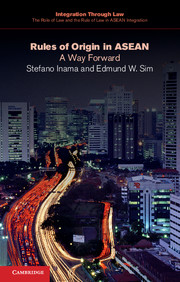Book contents
- Frontmatter
- Contents
- List of Tables
- General Editors’ preface
- Preface
- List of Abbreviations
- Chapter 1 Introduction
- Chapter 2 The initial set of ASEAN rules of origin: the lack of clarity and transparency masquerading as simplicity 1992–1995
- Chapter 3 Externalizing the confusion: the proliferation of rules in the ASEAN FTAs with dialogue partners
- Chapter 4 The silent cost: the cumbersome administration of ASEAN rules of origin
- Chapter 5 The possible way forward: self-certification
- Chapter 6 Conclusion and recommendations
- Executive Summary
- Appendices
- Bibliography
- Index
Chapter 6 - Conclusion and recommendations
Published online by Cambridge University Press: 05 March 2015
- Frontmatter
- Contents
- List of Tables
- General Editors’ preface
- Preface
- List of Abbreviations
- Chapter 1 Introduction
- Chapter 2 The initial set of ASEAN rules of origin: the lack of clarity and transparency masquerading as simplicity 1992–1995
- Chapter 3 Externalizing the confusion: the proliferation of rules in the ASEAN FTAs with dialogue partners
- Chapter 4 The silent cost: the cumbersome administration of ASEAN rules of origin
- Chapter 5 The possible way forward: self-certification
- Chapter 6 Conclusion and recommendations
- Executive Summary
- Appendices
- Bibliography
- Index
Summary
There are more than thirty RTAs in force involving East Asia, and many are led by ASEAN. Among the various methodologies for determining the origin of a good, ASEAN has followed its tradition as in many other trade issues: the ASEAN way. For more than two decades ASEAN used a percentage criterion of 40 percent. The drafting of the ASEAN legal texts concerning the calculation methodology of the 40 percent were far from clear and predictable, allowing for different methods used by different ASEAN countries. Recent reforms have introduced the concept of an RVC and the CTC as alternative criteria. An increasing number of products of PSROs are now being given the option to apply CTC as an alternative criterion to the 40 percent calculated as RVC.
The jury is still out on whether the addition of these alternative rules has resulted in a substantial increase of the utilization of ASEAN FTAs, today’s ATIGA. Table 1.1 in Chapter 1 indicates that much remains to be done to increase utilization rates.
The consolidation efforts made in the ATIGA made some improvements but they fall short; in sum, they are simply too little too late. An overall overhaul and rejuvenation of the ATIGA RoOs is necessary.
- Type
- Chapter
- Information
- Rules of Origin in ASEANA Way Forward, pp. 86 - 92Publisher: Cambridge University PressPrint publication year: 2015

